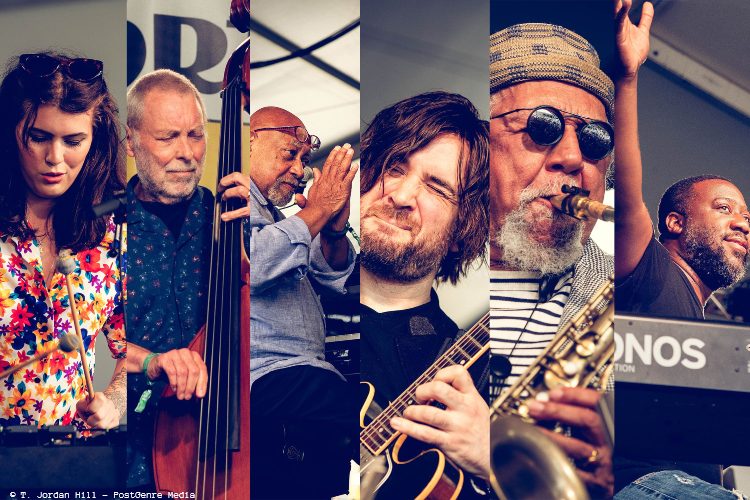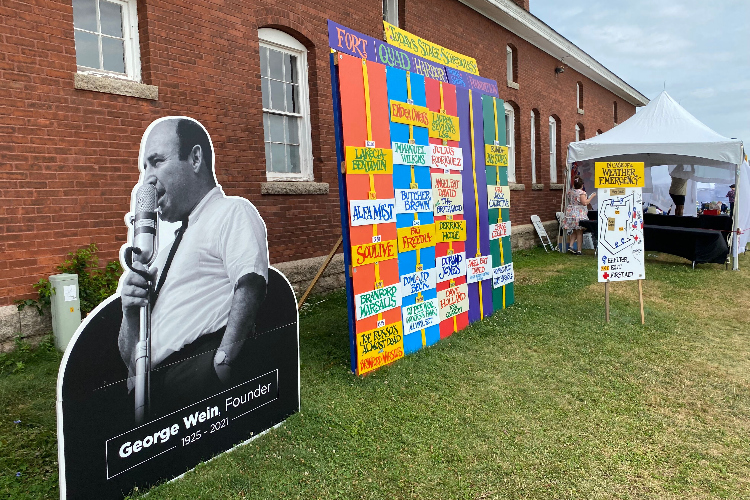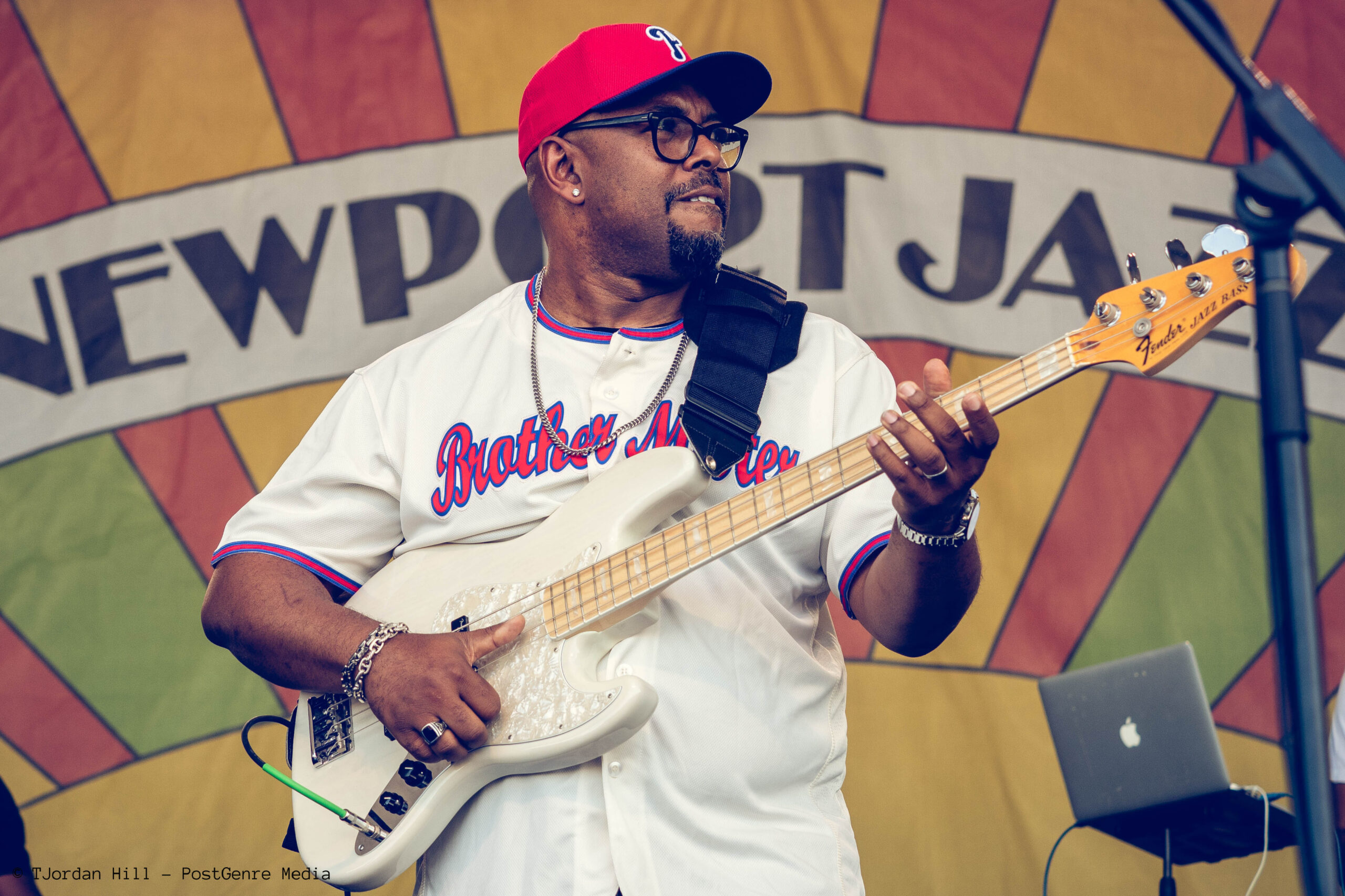Observations from Day Three of the 2021 Newport Jazz Festival
|
Getting your Trinity Audio player ready...
|
Jimmy Heath. Tony Allen. Chick Corea. Wallace Roney. McCoy Tyner. The names and pictures of iconic artists who passed since the last Newport Jazz Festival regularly flashed on both stage’s large screens between sets. While the Festival had made such touching presentations in years past, they were particularly noticeable at the 2021 Festival as thoughts of those lost were at the heart of the programming choices for the third day of the event, Sunday, August 1. For a music that has long revered its architects, a focus on elders should be unsurprising. At the same time, however, the day challenged the notion of what it means for an artist to be truly “gone” while celebrating the legends still among us.
The day started at the Quad Stage with the Vibes Summit, an exclusive performance by three of today’s top vibraphonists – Warren Wolf, Joel Ross, and Sasha Berliner – backed by pianist Emmet Cohen’s trio. With Wolf as the oldest performer (41 years old), it was a young collective and easy to overlook its historical antecedents, specifically Milt Jackson, Gary Burton, Lionel Hampton, Red Norvo, and Bobby Hutcherson congregating at the 1967 Newport Jazz Festival. In introducing Wolf, Ross, and Berliner, Artistic Director Christian McBride referenced this history, noting that while the vibes are not as prevalent in improvisatory music as other instruments, they have as rich a heritage as a trumpet or saxophone.
The 1967 Vibes Workshop built off of old Broadway songs like “Autumn in New York,” “How High the Moon,” and “Softly as in a Morning Sunrise.” The modern incarnation went a step further down the generational line, visiting the bebop compositions that themselves became standards off of the chord structures to such older tunes. A united ensemble traded bars over Gillespie’s “Be Bop” and Monk’s “Evidence,” adding new touches to each. In between, each vibraphonist was allowed to perform on their own in front of the trio.

First, Wolf added his vocals and mallets to Roy Ayers’ classic “Everybody Loves the Sunshine.” The choice was brilliant for several reasons. It subtly underscored connections to the 1967 Festival; while not part of the Vibes Workshop, Ayers was also at Newport that summer as part of Herbie Mann’s globetrotting quintet. Secondly, it emphasized Ayers’ role as a living legend in the lineage of vibraphone music. Finally, Wolf’s performance was soulful and laid back atop a tight drum rhythm. It sounded ripe for sampling, hinting at Ayers’ role as a heavily sampled artist and suggesting that musical approach’s role as a continuation in the historical narrative.

Sasha Berliner then shared a hauntingly beautiful rendition of “My Funny Valentine.” Her version, set to be released on next year’s Onyx, gave new life to an eighty-four-year-old song. Her unconventional use of echos and space suggested some exotic land just starting to be musically explored. As an aside, it was excellent to see Berliner as part of this performance. While Wolf and Ross both have strong groups of well-deserved followers, at times it seems their success has unfairly overshadowed Berliner. Her debut, Azalea (self-released, 2019), uniquely blurred alternative rock, jazz, and contemporary classical influences. Her work with Tyshawn Sorey has been equally compelling. Berliner is an artistic force to be reckoned with and it is commendable that the Festival seems cognizant of that fact.

Joel Ross added a contemporary spin on Coltrane’s “Cousin Mary.” At times, his instrument almost sounded bell-like in its clarity of tone. He also referenced Miles’ “Jean Pierre,” bridging the gap between music of the 1960s and 1980s.

Over on the Lawn Stage, harpist Brandee Younger led her ensemble with bassist Dezron Douglas and drummer Allan Mednard. During the pandemic, Younger and Douglas hosted several at-home livestream performances, including pieces released on Force Majure (International Anthem, 2020). In the process, the two string players developed an incredible ability to interact and respond to each other musically. This was evident at Newport on “Toilet Paper Romance” from that recording, as well as “Tickled Pink” from Younger’s newest album, Something Different (Impulse!, 2021). But while leaving focused on originals, Younger made sure to clarify that she is part of a heritage formed by Dorothy Ashby and Alice Coltrane before calling harpist Mikaela Davis out to join the group for Ashby’s “Action Line.”


Back inside the Fort’s walls, two NEA Jazz Masters prepared to take the Quad Stage with one of the finest drummers of his generation. Pianist Kenny Barron’s beautiful lyricism and bassist Dave Holland’s deep clear tone have well accentuated one another since their first recording together, The Art of Conversation (Impulse!, 2013). The addition of Johnathan Blake further adds motion and fluidity to their conversation. The trio presented songs from their latest, Without Deception (Dare2, 2020), a portfolio of compositions from both elders. The upbeat Latin-inspired “Porto Allegre.” The romantic balladry of “In Your Eyes.” The high-energy chase of “Speed Trap.” Each delicately underscored the importance of communication between improvising artists and how, when done correctly by skilled tacticians, such dialogues can expose new colors. But even these legendary artists left room to honor the past.

Monk’s “Worry Later” allowed the group to go a bit “out” even as it deemphasized some of its composer’s structural eccentricities. In so doing, it not only spotlighted Monk’s unique style but skills as a composer. A highlight of the performance, Holland’s composition, “Pass It On,” was dedicated to Ed Blackwell. Although perhaps best known for his work with Ornette Coleman, the exploration of Blackwell’s New Orleans roots primarily allowed for Afro-Latin and second line influences to emerge while providing an opportunity to showcase Blake’s drum skills.


Next on the Quad Stage was The Jazz Gallery All-Stars. Founded in 1995, New York City’s The Jazz Gallery has been at the forefront of supporting new and emerging artists.* Its role as such was evident in the group’s membership. Reading like a who’s who of today’s young voices in jazz – saxophonists Jaleel Shaw and Melissa Aldana, vibraphonist Joel Ross, guitarist Charles Altura, pianist Gerald Clayton, bassist Ben Williams, and drummer Marcus Gilmore – each have contributed to some of the most interesting original recordings of the past decade.
After an introduction by the Gallery’s Artistic Director, Rio Sakairi, the first half of the All-Stars’ set brought original compositions by some of the group’s members. Ross’ soft and dreamlike “Absence Makes the Heart Grow Fonder” was driven by vibes and guitar, while Clayton’s “Of Asking” resourcefully built a groove out of a simple melody.

With Gallery co-founder Lezlie Harrison in the audience, the second half found vocalist Renee Neufville stepping in front of the band to remember one of the club’s other two originators, Roy Hargrove.** Once a vocalist in the trumpeter’s RH Factor, Neufville led the group in blending R&B and jazz as that group once did. This included her use of lyrics that unequivocally marked out Hargrove’s lodestar such as “[i]f you could only see that the magic of your legacy would stand on its own feet.” To the crowd’s delight, this soon turned into a version of Hargrove’s perhaps best-known song, “Strasbourg/St. Denis.” Neufville then took the opportunity to morph this anthem into the Spinners’ “Could It Be I’m Falling in Love.” This crumbling of stylistic walls poignantly and powerfully posited that Hargrove belongs to the pantheon of legendary artists who shaped the music over the decades.

One such master musician, Charles Lloyd, took the Quad Stage following the All-Stars. The saxophonist began his set by reminiscing about his first time at Newport in 1961 as part of Chico Hamilton’s band. He also dedicated his performance to the Festival’s absent founder, noting that Wein belongs in the tradition outlined by “Armstrong Bird, Prez, and Lady Day.”

Lloyd has long been a potent analyst of the American sonic melting pot; an artist who extracts some of the finer points of various cultural ideas and places them together into a cohesive collage. In his first public performance in 18 months, he and his young band – Clayton, guitarist Marvin Sewell, drummer Eric Harland, and bassist Harish Raghavan – borrowed heavily from the blues. These influences were particularly apparent from Swell’s slide guitar and Harland’s rhythmic lines suggesting a train going down tracks. But even here, Middle Eastern flute motifs, gospel, and 60s soul hues, occasionally emerged through his revisitation of longstanding pieces like his “Dream Weaver.” And, in exploring Ornette Coleman’s “Ramblin’” these were also tied to free jazz. While Lloyd has little to prove at this point in his career, he inspired the audience with his continued expansiveness in search of new sounds.

The Quad Stage’s closer, the third of Artist-in-Residence Robert Glasper’s performances, provided a party-like atmosphere to end the weekend, complete with the group drinking from red solo cups. Throughout, there were even bubbles floating through the audience. Billed as a “Black Radio Presentation,” a common thread across the songs was the fusing of ideas from jazz, hip hop, and R&B. Though receiving significant attention for doing so since the first “Black Radio” album almost a decade ago, Glasper didn’t originate the concept of combining these influences. He also doesn’t claim to have done so. The broad phrase “Black Radio” itself suggests a shared cultural bandwidth between them, one explored by more recent legends like Hargrove and his fellow Soulquarian, the great composer J Dilla. This is where the Newport presentation- with Justin Tyson on drums, Burniss Travis on electric bass, Jahi Sundance on turntables, and Isaiah Sharkey on guitar- most excelled; in connecting the present moment to the genre-blurers of the past.
This was particularly evident once special guest Ledisi joined the ensemble. The vocalist was present at the Fort that weekend for her tribute to another boundary-pushing artist, Nina Simone. With Ledisi’s vocals added, the group performed “Gonna Be Alright (F.T.B.)” off of the first Black Radio album. Lyrics like “It’s gonna be alright, I know it’s going to be okay” took on profound importance after the year that was 2020. The song also briefly morphed into “Alright” off of Kendrick Lamar’s To Pimp a Butterfly.

Even more significant was the performance of “I’m Leaving You,” perhaps the best summation of the set. Originally produced for Everything’s Beautiful (Columbia, 2016), the piece is built around sounds from 1970s Miles Davis recordings but sounds fresh and modern. The heavy African-based groove produced by the band’s rhythm session sounded as if derived from albums like On the Corner (Columbia, 1972). At the same time, however, it fit comfortably alongside the rest of Glasper’s performances across the weekend. Jahi Sundance looped Miles’ own spoken word statement “wait a minute,” not only fighting the singer’s calls for an end of romance but also encapsulating the audience’s fascination with the band’s era-hopping traits. While it seems like a lost opportunity to have not pulled John Scofield into the performance – he was on the Fort grounds having just finished with The Jam Jawn – Sharkey produced a blistering solo before Jaleel Shaw jumped on stage to add a Maceo Parker-style funky one. Laying further into the funk influences, Glasper referenced James Brown by asking the audience to “Give the Drummer Some.” In all, “I’m Leaving You” was a great overview of the day; reverent of the past but without being bound to it.
Observations on Day One of the 2021 Newport Jazz Festival can be found here. Day Two can be found here.
Except as otherwise noted, all photos are by T. Jordan Hill of PostGenre Media.
* In the nature of full disclosure, this author also contributes to The Jazz Gallery’s Official Blog, Jazz Speaks.
** The third co-founder, Dale Fitzgerald, died in 2015 after a lengthy battle with cancer.




2 thoughts on “Observations from Day Three of the 2021 Newport Jazz Festival”